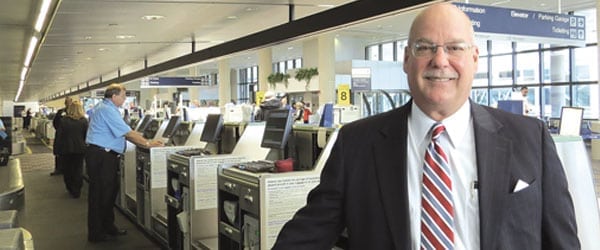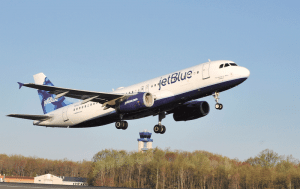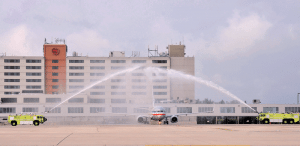
Route Geometry
Bradley Sets Lofty Goals for Growing Passenger Volume

JetBlue, which will be introducing nonstop service from Bradley to Fort Myers and Tampa this fall, is one many airlines adding routes at the airport.
Water cannons were spraying over the plane as it taxied for takeoff — a traditional sendoff in the aviation business — and before that there were speeches from Connecticut’s governor and officials from the airline. Balloons adorned the gate, and passengers walked over a red carpet to get on the aircraft.
The pomp and circumstance clearly indicated that this was not an ordinary flight, and, in most respects, it wasn’t. It marked the triumphant return of nonstop service from Bradley to the West Coast since airlines ceased such operations more than a decade ago, and Kevin Dillon is confident that this route has staying power.
He also believes that there will be many more ceremonies of a similar nature in the near future. In fact, some of them are no doubt already in the planning stages.
Indeed, in October, JetBlue will begin offering daily nonstop trips to Fort Myers and Tampa, Fla., joining Southwest Airlines in providing service to those cities out of Bradley. And Southwest is planning to add daily nonstop flights to Atlanta three days a week beginning in November, becoming a competitor to Delta in that service.
These new offerings are part of a multi-faceted strategic initiative being implemented by Dillon, executive director of the recently formed Connecticut Airport Authority (CAA), to boost passenger volume at Bradley and make it more of an economic force in the Hartford-Springfield region.
Like many medium-hub airports, Bradley suffered the loss of a number of routes in the wake of the recession, said Dillon, as airlines sought to pare expenses and become leaner operations. By adding more routes and creating competition with certain cities, such as Atlanta and Tampa, Bradley can bring down the cost of many tickets and provide more convenience to those it serves.
And these are just some of the many goals Dillon has set for Bradley. Others include everything from making the word ‘International’ in the facility’s name more meaningful — and accurate — by restoring service to Europe, which was discontinued after a very brief run a decade ago, to bringing more employers to the region by fully exploiting Connecticut’s new Bradley Airport Development Zone.
“This is an airport that has a whole lot of potential that has not been realized,” said Dillon, who took the reins at the CAA just over a year ago. “I think there’s a real opportunity to enhance the overall business. This is a great market area, not only geographically — halfway between Boston and New York — but also the relatively affluent population base, which lends itself to good air service. There is a lot of opportunity here.”
In a wide-ranging interview, BusinessWest talked with Dillon about his plans for Bradley, and how he plans to borrow lessons learned from a number of stops in a 38-year career in aviation and airport management as he goes about taking this regional asset to the proverbial next level.
Tracing His Routes
Dillon started his career with the Port Authority of New York and New Jersey, in its tunnels and bridges division.
“I quickly saw that the exciting line of business for the Port Authority was the aviation side, so I got myself transferred to aviation and started as a skycap supervisor,” he said, adding that he would go on to hold a number of positions at John F. Kennedy International and LaGuardia airports, including acting general manager at LaGuardia.
“Those years with the Port Authority gave me a good aviation background and education,” he said, “and really allowed me to achieve the things I’ve done within the industry.”
From there, he went on to serve as director of Aviation Operations at Logan International Airport in Boston for the Mass. Port Authority, and then became director of Manchester (N.H.) Airport, while also serving as chief executive of the city’s Aviation Department.
Subsequently, he served as the deputy executive director of Orlando International and Orlando Executive airports, and then served as president and CEO of the Rhode Island Airport Corp., beginning in early 2008.
At many of his stops, he’s been involved in large development initiatives. At Manchester, for example, he completed a $500 million capital-development program that included two terminal expansions, a parking garage, a new airport-entrance roadway, and extension of both runways. And in Boston, he was involved in the massive, $2 billion ‘Logan 2000’ initiative that included runway, terminal, and parking improvements.
He said the opportunity to lead the new Connecticut Airport Authority — and manage Bradley and the state’s five general aviation airports — represented an intriguing challenge.

The water-cannon salute was just part of the pageantry as American Airlines launched nonstop service from Bradley to Los Angeles last month.
While there are many aspects to his to-do list at Bradley, the primary assignment is to take the current annual passenger count, roughly 5 million, and move it incrementally closer to, and then hopefully beyond, the airport’s peak years just before the recession, when volume exceeded 7.5 million.
And the key to moving those numbers skyward, obviously, is routes, he told BusinessWest, adding that one of his primary goals is to officiate more ceremonies like the one on Aug. 27.
“When you think it through, every level of success at an airport depends on having healthy route structure,” he explained. “It generates passenger flow, and good passenger flow generates good revenues through the concessions, and good revenues at the airport generate the ability to build additional facilities.
“It really starts with good route structure,” he continued, “and this first year I’ve spent a lot of time analyzing the route structure and trying to enhance the opportunities, and I think we’ve had a good deal of success.”
Upon arriving at Bradley, Dillon told BusinessWest, he realized that, for the last several years, the state was not aggressively marketing the airport to airlines, and this resulted in stagnancy in the number of routes and passengers. One of the reasons for this may have been since-lifted restrictions on travel when it came to state employees.
“I don’t know how you could market the airport if you couldn’t travel and visit the airlines,” he said, adding that airport administrators have recently made up for lost time. “When I first arrived here, it became very clear to me that a lot of time needed to be spent talking to the airlines and convincing the airlines that there are good future plans for this facility.”
And this time and energy has generated results, he went on, citing American’s addition of the non-stop flight to Los Angeles, Southwest’s pending service to Atlanta, and JetBlue’s additional offerings to Florida. These new routes will heighten competition, which will ultimately benefit passengers.
“The more I can bring in competition, the better the price levels will be,” he explained. “There’s a strategy that goes into the route structure you have, because there are two things we’re trying to accomplish — add additional nonstop destinations that we don’t have today, but also bring in fair levels that will make this the airport of choice.”
Looking ahead, he said there are several areas of the country, as well as specific cities, for which Bradley would like to add nonstop service, or more such routes, as the case may be. These include the Texas market, other destinations in Florida, San Francisco, Phoenix, and others.
No Flights of Fancy
But another key to enabling Bradley to attain that ‘airport of choice’ status, of course, is the return of international service to Europe, said Dillon, noting that convenient trans-Atlantic service is vitally important to the local business community.
This was made clear in some recent research undertaken by their airport involving 23 area companies of various sizes. Among the questions put to these businesses were ones involving the size of their travel budgets and the frequency with which they used trans-Atlantic services. The results, said Dillon, were eye-opening.
“Just these 23 companies alone are spending about $40 million annually on trans-Atlantic service,” he noted. “That’s a significant number to take to an airline, combine with an airline-incentive program I’ve put in place here, and put together a great marketing package.”
The primary targets of such service would be London, Amsterdam, Frankfurt, and Paris, he went on, noting that connections can be made at those cities to virtually any city in Europe — and well outside it.
And officials at Bradley are currently putting their pitch together, he said, adding that, in addition to those impressive numbers from the business community, he can offer an incentive program that would waive airline-usage fees for a period of up to two years.
“That becomes a powerful selling point,” he said, adding that he is fairly confident that trans-Atlantic service can be returned to the airport. “Airlines know quite a bit about how much it would cost to operate out of Bradley Airport, but what they don’t have is that very detailed information about the demographics within the market. That’s where we can be extremely helpful to an airline in terms of convincing them to start service here.”
Beyond expansion of the route structure and building passenger volume, there are other immediate goals at Bradley, said Dillon, citing customer service as one.
Within that broad realm, there are plans to enhance not only physical facilities, but also what he called “empirical services,” with that latter category including everything from frequent-flyer programs to frequent-parker programs that will reward people for parking at the airport.
Plans are emerging for a frequent-flyer lounge, he told BusinessWest, adding that such an amenity would be another selling point in the effort to bring back trans-Atlantic service. Meanwhile, the airport is advancing plans for a consolidated transportation center that will house all of the rental cars that are currently scattered in and around the airport, and also handle bus service to the airport and, potentially, rail service that could become a component of enhanced commuter-rail operations between New Haven and Southern Vermont.
“There will be stops in Hartford and Windsor Locks,” he said of that rail-enhancement initiative currently underway. “At a minimum, I need to develop a high-frequency bus service back and forth between that Windsor Locks station and the airport, and who knows? If the volume is there at some point in the future, maybe that [transportation center] becomes a light-rail connection.”
As for the new rental-car facility, it brings a number of benefits for the airport.
“This is a great customer service in that the cars are now located in one convenient location that will be connected to the terminal facilities by a climate-controlled walkway,” he said, “but it will also free up all of this property that the rental-car companies are sitting on today for a higher and better use for economic-development purposes.”
Another goal for Dillon and the CAA is taking down the old, unused Terminal B, he said, adding that it has become a symbol of sorts of some of the downsizing and deterioration within the aviation industry.
“That terminal building is on the main entry to the airport,” he noted. “We want to demonstrate to people that this is a new day at Bradley, and we’re very anxious to take down that old terminal facility and start some new development.”
A third, very broad goal for the CAA is to enhance economic-development efforts at Bradley and the five smaller general-aviation airports in Connecticut, said Dillon, adding that the vehicles for growth will be economic-development zones created at each airport that feature tax incentives for those who locate or expand within them.
“What we would like to do is get out there and promote the availability of these zones, which provide tax incentives for relocation into those zones of businesses that are dedicated to either manufacturing or airport services,” he told BusinessWest. We want to make sure we’re making the best use of those as possible.”
With that, he summoned the term ‘aerotropolis,’ which is used within the industry to describe an airport-centered area devoted to economic development.
Such a facility already exists at Bradley, he said, noting that many manufacturing and airport-services business are located within a few miles of the airport. The goal is to expand that zone and bring more jobs that would benefit both Northern Conn. and Western Mass.
Soar Subject
As he mentioned earlier, Dillon expects that Bradley will be making extensive use of that red carpet rolled out on Aug. 27 at similar events in the weeks and months ahead.
The airport is being aggressive in its pursuit of new routes — and also new opportunities to better serve customers from across the Hartford-Springfield area.
And as it continues to add nonstop flights and amenities designed to make it easier for customers to reach their destinations, Bradley is ultimately clearing a way to get where it wants to go.
That would be status as the airport of choice.
George O’Brien can be reached at [email protected]





